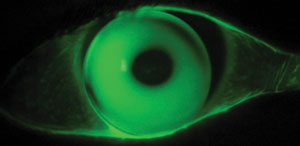 |
| Apical bearing by a rigid lens in keratoconus has been shown to induce epithelial thinning. Photo: Clark Y. Chang, OD. Click image to enlarge. |
A new study showed that thinning of the epithelium can occur in patients wearing any of these three types of contact lenses: soft, hard and mini scleral. This analysis stands out from others in that it differentiates between thinning patterns in keratoconus (KCN) patients and non-KCN patients. The researchers found that epithelial thinning occurred in different zones based on lens type and KCN status.
The cross-sectional study included 184 eyes (115 subjects), 75 who had KCN and 109 who did not. The researchers used 20 KCN eyes and 79 non-KCN eyes with no history of contact lens use as controls. For the lens users, the average duration of wear was 75.6 months.
They observed the most significant thinning in the peripheral zones in KCN mini scleral lens users, in both peripheral and central zones in non-KCN mini scleral lens users and in central zones in non-KCN hard lens users.
“The epithelial thickness of the non-KCN soft contact lens group was thinner than that of non-KCN control subjects all over the cornea; whereas, the epithelium of non-KCN hard contact lens users was thinner at the central site as well as nasal and temporal paracentral and midperipheral areas,” the researchers wrote in their paper.
For patients with KCN, the researchers noted that, interestingly, the epithelial thickness of the hard lens group and KCN control subjects was not significantly different in any of the sectors. On the other hand, compared with KCN controls, KCN patients who wore mini scleral lenses had a thinner epithelium at almost every peripheral sector, as well as inferior, inferotemporal, inferonasal and nasal midperipheral sectors.
“In keratoconic eyes, the epithelium showed thinning over the cone and an annular thickening zone adjacent to the cone, especially at the superonasal area,” the researchers wrote. “Additionally, contact lens-induced epithelial thinning may be combined with the epithelial remodeling resulting from KCN.” They also note that although no difference was shown in epithelial thickness between KCN HCL users and controls, the finding should be “interpreted with caution” due to variables in the study such as small sample size and differences in cone location and corneal irregularities between the two groups.
The researchers suggest based on the findings, “It is necessary to study keratoconic subjects apart from non-keratoconic ones in terms of contact lens effects.” Be vigilant of the potential effect of contact lens wear on corneal epithelial thickness in all of your patients, regardless of the type of lens worn or whether they have KCN.
Abdolalizadeh P, Karimi M, Latifi G, et al. Role of different types of contact lenses in epithelial thickness. Eye Contact Lens. March 24, 2022. [Epub ahead of print]. |

